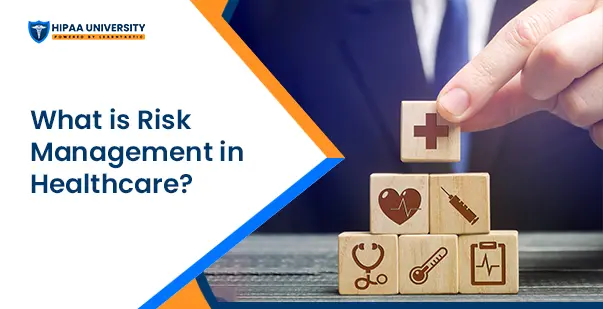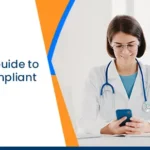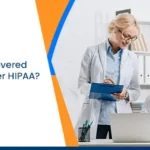Learn What is Risk Management In Healthcare?

September 6, 2024
Table Of Content
- Introduction
- The definition of risk management in healthcare
- What is enterprise risk management in healthcare?
- What are the effective risk management strategies in healthcare?
- Why is Risk Management Important to Healthcare Facilities?
- Situations or Scenarios that might need immediate Risk Management
- HIPAA and Risk Management: Correlation
- Conclusion
To answer, “What is risk management in healthcare”- it is a safety net that keeps patients and staff safe. Risk management identifies potential risks. This includes medical errors or accidents, and finds ways to prevent them. The goal is to create a safe environment where everyone feels protected.
In the healthcare domain, risks can come from anywhere. Be it patient care, medication administration, equipment use or cyber security, it is important to stay prepared. For example, did you know that medical errors are the third leading cause of death in the United States?
The Definition of Risk Management in Healthcare
Risk management isn’t just about avoiding mistakes. It is about creating a culture of safety. This means training staff, updating procedures, and continuously monitoring potential hazards. By doing this, healthcare organizations can reduce the chances of something going wrong.
Ready to dive deeper? Let’s explore how risk management works and why it’s essential for every healthcare provider.
What is enterprise risk management in healthcare?
Enterprise Risk Management (ERM) is a comprehensive approach to identify, assess, and manage risks across the entire organization. Unlike traditional risk management, which often focuses on specific areas.
To simplify, ERM helps healthcare organizations make better decisions.
- Holistic Approach:ERM covers all aspects of an organization. This includes patient care, finances, legal compliance, and reputation.
- Proactive Risk Identification: ERM emphasizes finding risks before they become problems, allowing for early intervention.
- Integration Across Departments: ERM connects risk management efforts across all departments, ensuring a unified strategy.
- Decision-Making Support: ERM provides valuable insights helping leaders make informed decisions. This helps balance risks and rewards.
- Continuous Monitoring: ERM involves ongoing risk assessment and adjustment of strategies to adapt to new challenges.
- Enhanced Patient Safety: By managing risks effectively, ERM helps create a safer environment for both patients and staff.
- Regulatory Compliance: ERM ensures that healthcare organizations stay compliant with laws and regulations, reducing the risk of penalties.
Read More: What is Protected Health Information?
What are the effective risk management strategies in healthcare?
Managing risk in healthcare enhances patient safety, staff well-being, and the overall success of the organization. Here are some effective strategies that healthcare facilities can implement to manage risks:
Comprehensive Risk Assessment- Regularly conduct thorough assessments to identify potential risks in all areas, from patient care to administrative processes. This helps pinpoint where the most significant threats lie.
Staff Training and Education- Ensure that all healthcare staff are properly trained in risk management practices. Regular training sessions on safety protocols, emergency procedures, and patient care reduces the likelihood of errors.
Clear Communication Channels- Establish clear and open communication channels within the organization. Encourage staff to report any concerns or potential risks without fear of retribution. This helps address issues before they escalate.
Implementing Technology Solutions- Use technology, such as electronic health records (EHRs) and automated monitoring systems, to track patient information and detect potential risks early. Technology can also help in standardizing procedures. This reduces the chance of human error.
Regular Audits and Monitoring- Continuously monitor and audit processes to ensure they meet safety and regulatory standards. Regular audits can reveal areas that need improvement and help maintain a high standard of care.
Creating a Safety Culture- Build a culture where safety is a top priority. This includes encouraging teamwork, maintaining a blame-free environment for reporting errors, and recognizing staff who contribute to a safer workplace.
Emergency Preparedness- Develop and regularly update emergency preparedness plans. Ensure that all staff know their roles in an emergency, whether it’s a natural disaster, a cyberattack, or a medical crisis.
Why is Risk Management Important to Healthcare Facilities?
By identifying and addressing potential risks, healthcare facilities prevent harm and improve care quality. Risk management also helps organizations maintain a strong reputation.
Key Reasons Why Risk Management is Important:
- Patient Safety: Protecting patients from harm is the top priority. Effective risk management prevents medical errors and accidents that could put patients at risk.
- Staff Well-being:A safe working environment is crucial for healthcare staff. Risk management practices help reduce workplace injuries, This creates a safer, more supportive environment for employees.
- Compliance with Regulations: Healthcare facilities must follow strict laws and regulations. Risk management ensures that the organization stays compliant, avoiding fines and legal issues.
- Financial Stability: Managing risks can prevent costly errors, lawsuits, and penalties. This maintains the financial health of the facility and allows it to invest in better patient care.
- Improved Reputation: A strong risk management program enhances the facility’s reputation by demonstrating a commitment to safety and quality care. Patients and families are more likely to trust and choose a facility that prioritizes their well-being.
- Better Decision-Making: With risk management, healthcare leaders can make informed decisions that balance safety, quality, and cost-effectiveness. This leads to better outcomes for everyone involved.
Situations or Scenarios that might need immediate Risk Management
Risk management is crucial in healthcare, especially when unexpected situations arise. Here are some scenarios that might need immediate attention:
- Medication Errors If a patient is given the wrong medication or dosage, immediate action is needed to prevent harm.
- Patient Falls A patient falling can lead to serious injuries. Quick intervention is necessary to assess the damage and prevent further incidents.
- Infection Outbreak If an infection spreads within the facility, it’s vital to identify the source and implement containment measures immediately.
- Data Breach A cybersecurity breach exposing patient information requires immediate action to secure data and notify affected individuals.
- Equipment Failure If life-saving equipment malfunctions, quick troubleshooting or replacement is necessary to avoid compromising patient care.
- Adverse ReactionsIf a patient has an unexpected allergic reaction to a treatment, rapid response is essential to manage the situation.
- Staff Shortage A sudden shortage of medical staff can affect patient care. Immediate risk management is needed to ensure coverage and maintain service quality.
- Natural Disasters In the event of a natural disaster like a hurricane or earthquake, emergency plans must be activated to protect patients and staff.
- Violence or AggressionIf a patient or visitor becomes violent, quick action is required to de-escalate the situation and ensure safety.
Read More: How to Make Your Email HIPAA Compliant
HIPAA and Risk Management: Correlation
The correlation between HIPAA and risk management is the shared goal of protecting data and ensuring compliance.
Key Points on the Correlation:
- Data ProtectionHIPAA requires healthcare organizations to safeguard patient information. Risk management helps identify threats in data handling. This ensures compliance with HIPAA’s security rules.
- Preventing Breaches A strong risk management program helps prevent data breaches by regularly assessing and addressing potential risks to patient information, aligning with HIPAA’s requirements.
- Compliance Risk management supports HIPAA compliance by ensuring that all aspects of data security and privacy are regularly reviewed and updated to meet legal standards.
- Incident Response Both HIPAA and risk management emphasize the importance of having a plan in place to respond to security incidents quickly and effectively.
- Training and Awareness HIPAA mandates regular training on data privacy and security. Risk management includes ongoing education to keep staff informed about best practices.
Conclusion
Exploring the question- what is risk management in healthcare, we have understood its critical importance, especially in the healthcare setting. By systematically following the steps mentioned above, facilities can prevent errors and provide the best possible care to patients. Risk management also helps healthcare bodies navigate the regulations and compliances in place. This helps avoid legal issues and penalties.
In essence, risk management is more than just a set of procedures. It is an ongoing commitment to safety, quality and excellence. With the healthcare market continuing to evolve, the role of risk management can only grow in importance.





